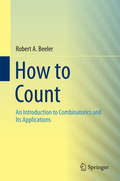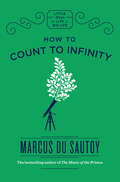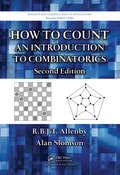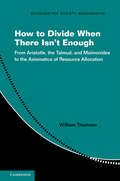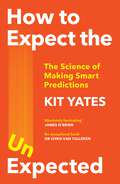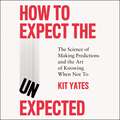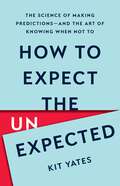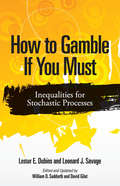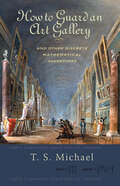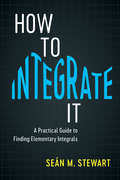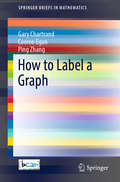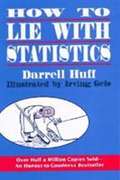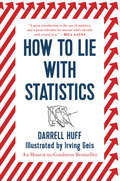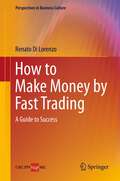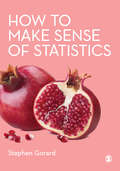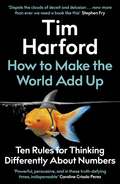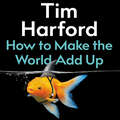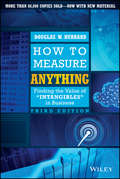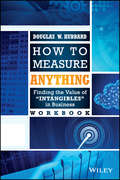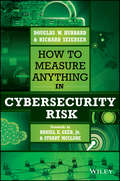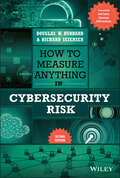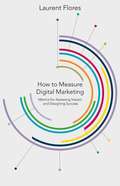- Table View
- List View
How to Count
by Robert A. BeelerProviding a self-contained resource for upper undergraduate courses in combinatorics, this text emphasizes computation, problem solving, and proof technique. In particular, the book places special emphasis the Principle of Inclusion and Exclusion and the Multiplication Principle. To this end, exercise sets are included at the end of every section, ranging from simple computations (evaluate a formula for a given set of values) to more advanced proofs. The exercises are designed to test students' understanding of new material, while reinforcing a working mastery of the key concepts previously developed in the book. Intuitive descriptions for many abstract techniques are included. Students often struggle with certain topics, such as generating functions, and this intuitive approach to the problem is helpful in their understanding. When possible, the book introduces concepts using combinatorial methods (as opposed to induction or algebra) to prove identities. Students are also asked to prove identities using combinatorial methods as part of their exercises. These methods have several advantages over induction or algebra.
How to Count to Infinity
by Marcus Du SautoyDo something amazing and learn a new skill thanks to the Little Ways to Live a Big Life books! Birds do it, bees do it, even educated fleas do it... Not falling in love, but counting. Animals and humans have been using numbers to navigate their way through the jungle of life ever since we all evolved on this planet. But this book will help you to do something that humans have only recently understood how to do: to count to regions that no animal has ever reached. By the end of this book you'll be able to count to infinity...and beyond.On our way to infinity we'll discover how the ancient Babylonians used their bodies to count to 60 (which gave us 60 minutes in the hour), how the number zero was only discovered in the 7th century by Indian mathematicians contemplating the void, why in China going into the red meant your numbers had gone negative and why numbers might be our best language for communicating with alien life.But for millennia contemplating infinity has sent even the greatest minds into a spin. Then at the end of the nineteenth century mathematicians discovered a way to think about infinity that revealed that it is a number that we can count. Not only that. They found that there are an infinite number of infinities, some bigger than others. Just using the finite neurons in your brain and the finite pages in this book, you'll have your mind blown discovering the secret of how to count to infinity.
How to Count to Infinity (Little Ways to Live a Big Life #1)
by Marcus Du SautoyDo something amazing and learn a new skill thanks to the Little Ways to Live a Big Life books! Birds do it, bees do it, even educated fleas do it... Not falling in love, but counting. Animals and humans have been using numbers to navigate their way through the jungle of life ever since we all evolved on this planet. But this book will help you to do something that humans have only recently understood how to do: to count to regions that no animal has ever reached. By the end of this book you'll be able to count to infinity...and beyond.On our way to infinity we'll discover how the ancient Babylonians used their bodies to count to 60 (which gave us 60 minutes in the hour), how the number zero was only discovered in the 7th century by Indian mathematicians contemplating the void, why in China going into the red meant your numbers had gone negative and why numbers might be our best language for communicating with alien life.But for millennia contemplating infinity has sent even the greatest minds into a spin. Then at the end of the nineteenth century mathematicians discovered a way to think about infinity that revealed that it is a number that we can count. Not only that. They found that there are an infinite number of infinities, some bigger than others. Just using the finite neurons in your brain and the finite pages in this book, you'll have your mind blown discovering the secret of how to count to infinity.
How to Count: An Introduction to Combinatorics, Second Edition
by R.B.J.T. Allenby Alan SlomsonEmphasizes a Problem Solving ApproachA first course in combinatoricsCompletely revised, How to Count: An Introduction to Combinatorics, Second Edition shows how to solve numerous classic and other interesting combinatorial problems. The authors take an easily accessible approach that introduces problems before leading into the theory involved. Although the authors present most of the topics through concrete problems, they also emphasize the importance of proofs in mathematics.New to the Second EditionThis second edition incorporates 50 percent more material. It includes seven new chapters that cover occupancy problems, Stirling and Catalan numbers, graph theory, trees, Dirichlet's pigeonhole principle, Ramsey theory, and rook polynomials. This edition also contains more than 450 exercises. Ideal for both classroom teaching and self-study, this text requires only a modest amount of mathematical background. In an engaging way, it covers many combinatorial tools, such as the inclusion-exclusion principle, generating functions, recurrence relations, and Polya's counting theorem.
How to Divide When There Isn't Enough: From Aristotle, the Talmud, and Maimonides to the Axiomatics of Resource Allocation (Econometric Society Monographs #62)
by William ThomsonHow to Divide When There Isn't Enough develops a rigorous yet accessible presentation of the state-of-the-art for the adjudication of conflicting claims and the theory of taxation. It covers all aspects one may wish to know about claims problems: the most important rules, the most important axioms, and how these two sets are related. More generally, it also serves as an introduction to the modern theory of economic design, which in the last twenty years has revolutionized many areas of economics, generating a wide range of applicable allocations rules that have improved people's lives in many ways. In developing the theory, the book employs a variety of techniques that will appeal to both experts and non-experts. Compiling decades of research into a single framework, William Thomson provides numerous applications that will open a large number of avenues for future research.
How to Expect the Unexpected: The Science of Making Predictions and the Art of Knowing When Not To
by Kit Yates'Yates' writing is a beacon of clarity sorely needed in a complicated and confusing world... I'll be quoting from this book' Jim Al-KhaliliAre you more likely to become a professional footballer if your surname is Ball?· How can you be one hundred per cent sure you will win a bet?· Why did so many Pompeiians stay put while Mount Vesuvius was erupting?· How do you prevent a nuclear war?Ever since the dawn of human civilisation, we have been trying to make predictions about what's in store for us. We do this on a personal level, so that we can get on with our lives efficiently (should I hang my laundry out to dry, or will it rain?). But we also have to predict on a much larger scale, often for the good of our broader society (how can we spot economic downturns or prevent terrorist attacks?). For just as long, we have been getting it wrong. From religious oracles to weather forecasters, and from politicians to economists, we are subjected to poor predictions all the time. Our job is to separate the good from the bad. Unfortunately, the foibles of our own biology - the biases that ultimately make us human - can let us down when it comes to making rational inferences about the world around us. And that can have disastrous consequences. How to Expect the Unexpected will teach you how and why predictions go wrong, help you to spot phony forecasts and give you a better chance of getting your own predictions correct.
How to Expect the Unexpected: The Science of Making Predictions and the Art of Knowing When Not To
by Kit YatesA fascinating exploration of how we can make better, accessible, mathematically-informed predictions about the world around us.· Are you more likely to become a professional footballer if your surname is Ball?· Is winning the National Lottery not once, but twice really as unlikely as it sounds?· Why did so many Pompeiians stay put while Mount Vesuvius was erupting?· How do you prevent a nuclear war?Ever since the dawn of human civilisation, we have been trying to make predictions about what's in store for us. We do this on a personal level, so that we can get on with our lives efficiently (should I hang my laundry out to dry, or will it rain?). But we also have to predict on a much larger scale, often for the good of our broader society (how can we spot economic downturns or prevent terrorist attacks?). For just as long, we have been getting it wrong. From religious oracles to weather forecasters, and from politicians to economists, we are subjected to poor predictions all the time. Our job is to separate the good from the bad. Unfortunately, the foibles of our own biology - the biases that ultimately make us human - can let us down when it comes to making rational inferences about the world around us. And that can have disastrous consequences. How to Expect the Unexpected will teach you how and why predictions go wrong, help you to spot phony forecasts and give you a better chance of getting your own predictions correct.(P) 2023 Quercus Editions Limited
How to Expect the Unexpected: The Science of Making Predictions—and the Art of Knowing When Not To
by Kit YatesA &“vivid, wide-ranging, and delightful guide&” (bestselling author Tim Harford) for understanding how and why predictions go wrong, with practical tips to give you a better chance of getting them right How can you be 100 percent sure you will win a bet? Why did so many Pompeians stay put while Mount Vesuvius was erupting? Are you more likely to work in a kitchen if your last name is Baker? Ever since the dawn of human civilization, we have been trying to make predictions about what the world has in store for us. For just as long, we have been getting it wrong. In How to Expect the Unexpected, mathematician Kit Yates uncovers the surprising science that undergirds our predictions—and how we can use it to our advantage. From religious oracles to weather forecasters, and from politicians to economists, we are subjected to poor predictions all the time. Synthesizing results from math, biology, psychology, sociology, medicine, economic theory, and physics, Yates provides tools for readers to understand uncertainty and to recognize the cognitive biases that make accurate predictions so hard to come by. This book will teach you how and why predictions go wrong, help you to spot phony forecasts, and give you a better chance of getting your own predictions correct.
How to Gamble If You Must: Inequalities for Stochastic Processes (Dover Books on Mathematics)
by Leonard J. Savage Prof. William Sudderth Lester E. Dubins Prof. David GilatThis classic of advanced statistics is geared toward graduate-level readers and uses the concepts of gambling to develop important ideas in probability theory. The authors have distilled the essence of many years' research into a dozen concise chapters. "Strongly recommended" by the Journal of the American Statistical Association upon its initial publication, this revised and updated edition features contributions from two well-known statisticians that include a new Preface, updated references, and findings from recent research. Following an introductory chapter, the book formulates the gambler's problem and discusses gambling strategies. Succeeding chapters explore the properties associated with casinos and certain measures of subfairness. Concluding chapters relate the scope of the gambler's problems to more general mathematical ideas, including dynamic programming, Bayesian statistics, and stochastic processes.
How to Guard an Art Gallery and Other Discrete Mathematical Adventures
by T.S. MichaelWhat is the maximum number of pizza slices one can get by making four straight cuts through a circular pizza? How does a computer determine the best set of pixels to represent a straight line on a computer screen? How many people at a minimum does it take to guard an art gallery?Discrete mathematics has the answer to these—and many other—questions of picking, choosing, and shuffling. T. S. Michael's gem of a book brings this vital but tough-to-teach subject to life using examples from real life and popular culture. Each chapter uses one problem—such as slicing a pizza—to detail key concepts about counting numbers and arranging finite sets. Michael takes a different perspective in tackling each of eight problems and explains them in differing degrees of generality, showing in the process how the same mathematical concepts appear in varied guises and contexts. In doing so, he imparts a broader understanding of the ideas underlying discrete mathematics and helps readers appreciate and understand mathematical thinking and discovery.This book explains the basic concepts of discrete mathematics and demonstrates how to apply them in largely nontechnical language. The explanations and formulas can be grasped with a basic understanding of linear equations.
How to Guard an Art Gallery: And Other Discrete Mathematical Adventures
by T.S. MichaelAn “accessible and engaging” tool for understanding the branch of mathematics that is so crucial to modern computer science, using real-life problems (Mathematical Reviews).What is the maximum number of pizza slices one can get by making four straight cuts through a circular pizza? How does a computer determine the best set of pixels to represent a straight line on a computer screen? How many people at a minimum does it take to guard an art gallery?Discrete mathematics has the answer to these—and many other—questions of picking, choosing, and shuffling. T. S. Michael’s gem of a book brings this vital but tough-to-teach subject to life using examples from the real world and popular culture. Each chapter uses one problem—such as slicing a pizza—to detail key concepts about counting numbers and arranging finite sets. Michael takes a different perspective in tackling each of eight problems and explains them in differing degrees of generality, showing in the process how the same mathematical concepts appear in varied guises and contexts. In doing so, he imparts a broader understanding of the ideas underlying discrete mathematics and helps readers appreciate and understand mathematical thinking and discovery.This book explains the basic concepts of discrete mathematics and demonstrates how to apply them in largely nontechnical language. The explanations and formulas can be grasped with a basic understanding of linear equations.
How to Integrate It: A Practical Guide to Finding Elementary Integers
by Seán M. StewartWhile differentiating elementary functions is merely a skill, finding their integrals is an art. This practical introduction to the art of integration gives readers the tools and confidence to tackle common and uncommon integrals. After a review of the basic properties of the Riemann integral, each chapter is devoted to a particular technique of elementary integration. Thorough explanations and plentiful worked examples prepare the reader for the extensive exercises at the end of each chapter. These exercises increase in difficulty from warm-up problems, through drill examples, to challenging extensions which illustrate such advanced topics as the irrationality of π and e, the solution of the Basel problem, Leibniz's series and Wallis's product. The author's accessible and engaging manner will appeal to a wide audience, including students, teachers and self-learners. The book can serve as a complete introduction to finding elementary integrals, or as a supplementary text for any beginning course in calculus. A systematic introduction to integration, containing many fully worked examples to demonstrate how the techniques are applied in practice Contains more than 500 exercises ranging in difficulty, from warm-ups to challenging extensions Accessible and engaging, this book will be of interest to students, teachers and self-learners.
How to Label a Graph (SpringerBriefs in Mathematics)
by Ping Zhang Gary Chartrand Cooroo EganThis book depicts graph labelings that have led to thought-provoking problems and conjectures. Problems and conjectures in graceful labelings, harmonious labelings, prime labelings, additive labelings, and zonal labelings are introduced with fundamentals, examples, and illustrations. A new labeling with a connection to the four color theorem is described to aid mathematicians to initiate new methods and techniques to study classical coloring problems from a new perspective. Researchers and graduate students interested in graph labelings will find the concepts and problems featured in this book valuable for finding new areas of research.
How to Lie with Statistics
by Darrell Huff Irving GeisA 1954 classic that continues to dispel false beliefs and inform the statistically naive. Huff's direct and witty style exposes how advertisers, government and the media mislead their audiences through the misuse of statistics. Huff then explains how the reader can see through the smoke and mirrors to get to the real meaning-- if any-- of what is presented. Annotation c. by Book News, Inc., Portland, Or.
How to Lie with Statistics (Pelican Ser.)
by Darrell Huff Irving GeisOver Half a Million Copies Sold--an Honest-to-Goodness Bestseller Darrell Huff runs the gamut of every popularly used type of statistic, probes such things as the sample study, the tabulation method, the interview technique, or the way the results are derived from the figures, and points up the countless number of dodges which are used to full rather than to inform.
How to Make Money by Fast Trading
by Renato Di LorenzoAll over the world a growing number of people are viewing trading the markets as a valuable source of additional income or even as a new career option. Sitting in front of a PC, they are able to connect to their broker's trading platform and buy or sell on the world market assets of all kinds: gold, oil, shares, bonds, and so forth. Today, it is no longer a problem to "be short" on almost any class of asset. This book is an ideal guide on how to make money by fast trading. It will be especially valuable for those wishing to trade in their spare time with a limited amount of capital. Different styles of trading, including scalping, day trading, and swing trading, are clearly described, with advice on how to avoid common mistakes. In addition, the "Donkey" trading system - a system designed for everybody - is fully explained. Using this book, the reader will learn how to manage risk safely, maximizing the likelihood of success.
How to Make Sense of Statistics
by Stephen GorardIn a new textbook designed for students new to statistics and social data, Stephen Gorard focuses on non-inferential statistics as a basis to ensure students have basic statistical literacy. Understanding why we have to learn statistics and seeing the links between the numbers and real life is a crucial starting point. Using engaging, friendly, approachable language this book will demystify numbers from the outset, explaining exactly how they can be used as tools to understand the relationships between variables. This text assumes no previous mathematical or statistical knowledge, taking the reader through each basic technique with step-by-step advice, worked examples, and exercises. Using non-inferential techniques, students learn the foundations that underpin all statistical analysis and will learn from the ground up how to produce theoretically and empirically informed statistical results.
How to Make Sense of Statistics
by Stephen GorardIn a new textbook designed for students new to statistics and social data, Stephen Gorard focuses on non-inferential statistics as a basis to ensure students have basic statistical literacy. Understanding why we have to learn statistics and seeing the links between the numbers and real life is a crucial starting point. Using engaging, friendly, approachable language this book will demystify numbers from the outset, explaining exactly how they can be used as tools to understand the relationships between variables. This text assumes no previous mathematical or statistical knowledge, taking the reader through each basic technique with step-by-step advice, worked examples, and exercises. Using non-inferential techniques, students learn the foundations that underpin all statistical analysis and will learn from the ground up how to produce theoretically and empirically informed statistical results.
How to Make the World Add Up: Ten Rules for Thinking Differently About Numbers
by Tim HarfordThe Sunday Times Top Ten bestseller'Tim Harford could well be Britain's Malcolm Gladwell'Alex Bellos, author of Alex's Adventures in Numberland'If you aren't in love with stats before reading this book, you will be by the time you're done. Powerful, persuasive, and in these truth-defying times, indispensable'Caroline Criado Perez, author of Invisible Women In How to Make the World Add Up, Tim Harford draws on his experience as both an economist and presenter of the BBC's radio show 'More or Less' to take us deep into the world of disinformation and obfuscation, bad research and misplaced motivation to find those priceless jewels of data and analysis that make communicating with numbers so rewarding. Through vivid storytelling he reveals how we can evaluate the claims that surround us with confidence, curiosity and a healthy level of scepticism. It is a must-read for anyone who cares about understanding the world around them.'Tim Harford is our most likeable champion of reason and rigour . . . clear, clever and always highly readable'The Times, Books of the Year'Fascinating and enjoyable'Bill Bryson'Now more than ever we need a book like this'Stephen Fry'Wise, humane and, above all, illuminating. Nobody is better on statistics and numbers - and how to make sense of them'Matthew Syed'One of the most wonderful collections of stories that I have read in a long time . . . fascinating.'Steven Levitt, co-author of Freakonomics'Wise and useful . . . such a delight' Financial Times'What should we do when someone makes a claim that they say is based on data? This wise book, distilled from years of experience, gives us the ten commandments, from first examining our feelings, to finally having the humility to admit we may be wrong. Priceless'Professor Sir David Spiegelhalter
How to Make the World Add Up: Ten Rules for Thinking Differently About Numbers
by Tim HarfordThe Sunday Times Bestseller'Tim Harford is one of my favourite writers in the world. His storytelling is gripping but never overdone, his intellectual honesty is rare and inspiring, and his ability to make complex things simple - but not simplistic - is exceptional. How to Make the World Add Up is another one of his gems. If you're looking for an addictive pageturner that will make you smarter, this is your book' Rutger Bregman, author of Humankind'Tim Harford could well be Britain's Malcolm Gladwell'Alex Bellos, author of Alex's Adventures in Numberland'If you aren't in love with stats before reading this book, you will be by the time you're done. Powerful, persuasive, and in these truth-defying times, indispensable'Caroline Criado Perez, author of Invisible Women In How to Make the World Add Up, Tim Harford draws on his experience as both an economist and presenter of the BBC's radio show 'More or Less' to take us deep into the world of disinformation and obfuscation, bad research and misplaced motivation to find those priceless jewels of data and analysis that make communicating with numbers so rewarding. Through vivid storytelling he reveals how we can evaluate the claims that surround us with confidence, curiosity and a healthy level of scepticism. It is a must-read for anyone who cares about understanding the world around them.'Tim Harford is our most likeable champion of reason and rigour . . . clear, clever and always highly readable'The Times, Books of the Year 'Fascinating and enjoyable'Bill Bryson'Now more than ever we need a book like this'Stephen Fry'Wise, humane and, above all, illuminating. Nobody is better on statistics and numbers - and how to make sense of them'Matthew Syed'One of the most wonderful collections of stories that I have read in a long time . . . fascinating.'Steven Levitt, co-author of Freakonomics'Wise and useful . . . such a delight' Financial Times'What should we do when someone makes a claim that they say is based on data? This wise book, distilled from years of experience, gives us the ten commandments, from first examining our feelings, to finally having the humility to admit we may be wrong. Priceless'Professor Sir David Spiegelhalter
How to Measure Anything
by Douglas W. HubbardNow updated with new measurement methods and new examples, How to Measure Anything shows managers how to inform themselves in order to make less risky, more profitable business decisionsThis insightful and eloquent book will show you how to measure those things in your own business, government agency or other organization that, until now, you may have considered "immeasurable," including customer satisfaction, organizational flexibility, technology risk, and technology ROI.Adds new measurement methods, showing how they can be applied to a variety of areas such as risk management and customer satisfactionSimplifies overall content while still making the more technical applications available to those readers who want to dig deeperContinues to boldly assert that any perception of "immeasurability" is based on certain popular misconceptions about measurement and measurement methodsShows the common reasoning for calling something immeasurable, and sets out to correct those ideasOffers practical methods for measuring a variety of "intangibles"Provides an online database (www.howtomeasureanything.com) of downloadable, practical examples worked out in detailed spreadsheetsWritten by recognized expert Douglas Hubbard--creator of Applied Information Economics--How to Measure Anything, Third Edition illustrates how the author has used his approach across various industries and how any problem, no matter how difficult, ill defined, or uncertain can lend itself to measurement using proven methods.
How to Measure Anything Workbook
by Douglas W. HubbardThe invaluable companion to the new edition of the bestselling How to Measure AnythingThis companion workbook to the new edition of the insightful and eloquent How to Measure Anything walks readers through sample problems and exercises in which they can master and apply the methods discussed in the book.The book explains practical methods for measuring a variety of intangibles, including approaches to measuring customer satisfaction, organizational flexibility, technology risk, technology ROI, and other problems in business, government, and not-for-profits.Companion to the revision of the bestselling How to Measure AnythingProvides chapter-by-chapter exercisesWritten by industry leader Douglas HubbardWritten by recognized expert Douglas Hubbard--creator of Applied Information Economics--How to Measure Anything Workbook illustrates how the author has used his approach across various industries and how any problem, no matter how difficult, ill defined, or uncertain can lend itself to measurement using proven methods.
How to Measure Anything in Cybersecurity Risk
by Stuart Mcclure Douglas W. Hubbard Richard Seiersen Daniel E. Geer Jr.A ground shaking exposé on the failure of popular cyber risk management methods How to Measure Anything in Cybersecurity Risk exposes the shortcomings of current "risk management" practices, and offers a series of improvement techniques that help you fill the holes and ramp up security. In his bestselling book How to Measure Anything, author Douglas W. Hubbard opened the business world's eyes to the critical need for better measurement. This book expands upon that premise and draws from The Failure of Risk Management to sound the alarm in the cybersecurity realm. Some of the field's premier risk management approaches actually create more risk than they mitigate, and questionable methods have been duplicated across industries and embedded in the products accepted as gospel. This book sheds light on these blatant risks, and provides alternate techniques that can help improve your current situation. You'll also learn which approaches are too risky to save, and are actually more damaging than a total lack of any security. Dangerous risk management methods abound; there is no industry more critically in need of solutions than cybersecurity. This book provides solutions where they exist, and advises when to change tracks entirely. Discover the shortcomings of cybersecurity's "best practices" Learn which risk management approaches actually create risk Improve your current practices with practical alterations Learn which methods are beyond saving, and worse than doing nothing Insightful and enlightening, this book will inspire a closer examination of your company's own risk management practices in the context of cybersecurity. The end goal is airtight data protection, so finding cracks in the vault is a positive thing--as long as you get there before the bad guys do. How to Measure Anything in Cybersecurity Risk is your guide to more robust protection through better quantitative processes, approaches, and techniques.
How to Measure Anything in Cybersecurity Risk
by Douglas W. Hubbard Richard SeiersenA start-to-finish guide for realistically measuring cybersecurity risk In the newly revised How to Measure Anything in Cybersecurity Risk, Second Edition, a pioneering information security professional and a leader in quantitative analysis methods delivers yet another eye-opening text applying the quantitative language of risk analysis to cybersecurity. In the book, the authors demonstrate how to quantify uncertainty and shed light on how to measure seemingly intangible goals. It's a practical guide to improving risk assessment with a straightforward and simple framework. Advanced methods and detailed advice for a variety of use cases round out the book, which also includes: A new "Rapid Risk Audit" for a first quick quantitative risk assessment. New research on the real impact of reputation damage New Bayesian examples for assessing risk with little data New material on simple measurement and estimation, pseudo-random number generators, and advice on combining expert opinion Dispelling long-held beliefs and myths about information security, How to Measure Anything in Cybersecurity Risk is an essential roadmap for IT security managers, CFOs, risk and compliance professionals, and even statisticians looking for novel new ways to apply quantitative techniques to cybersecurity.
How to Measure Digital Marketing: Metrics for Assessing Impact and Designing Success
by Laurent FlorésMeasuring the Success of Digital Marketing explains how to determine the success of a digital marketing campaign by demonstrating what digital marketing metrics are as well as how to measure and use them. Including real life case studies and experts viewpoints that help marketers navigate the digital world.
